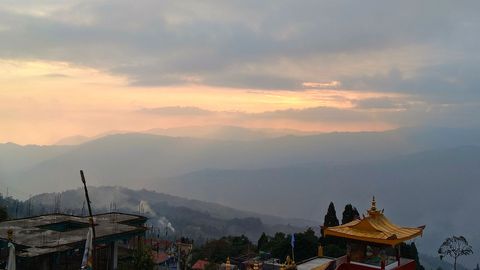
First, I had noticed the trees: lush, leafy, and brooding. They were towering, almost touching the skies, aided by the mountains. Oak and pine were unrecognisable when covered in a thick layer of moss. Then I saw the plantations until it was all I could see vast, expansive, and miles and miles of what Darjeeling is best known for—tea. Yet it is the memory of a village nestled in the foothills of the Darjeeling district that I return to the most. Gorabari, a quaint town far removed from the hustle of cities, is often considered a pitstop for tourists on their way to Darjeeling town, which is merely half an hour away. Its charm could rival Darjeeling’s reputation as a commercial destination. The allure of the village, however, is markedly different from living in the hubbub of the favoured town, which is a sensory carnival with famed cafes on Mall Road, tea boutiques at every juncture, scrumptious food, and a vibrant stream of tourists from across the world.
As The Time Stops

Gorabari, in contrast, offers a different journey for the senses. At seven o’clock each evening, the streets fall silent. The night sky is dotted with stars, breathing life into this otherwise quiet, sleepy hamlet. Time moves slowly here, almost elastically: unrushed, easy, and relaxed. As a child, I often passed by the village while visiting Darjeeling with my parents, but it only became my preferred stop when my sister started teaching at a nearby college.
Surprises At Every Turn
When I would return, I always found the neon-coloured cottages an interesting twist to the otherwise humdrum nature of the villagers. Bright primaries paved the way, with roses, sunflowers, orchids, and clematises adorning the balconies of these homes. In every nook and cranny, I could find a momo shop, each more delectable than the other, fighting to keep its place as the best in the world, served with spicy dalle. The smell of freshly cooked baos, in Sonada’s food shops, a town a stone’s throw away from Gorabari, always enticed me for a second serving. But time and time again, I would find they had sold out.

Coconuts are an anomaly in the Himalayan hill stations, yet coconut cookies were plentiful at Maasum Bakery. During one of my errands to buy bread, the shop owner kindly offered me one of these crusty cookies. And it’s safe to say, one cookie was never enough. Across from Salesian College, a prominent landmark in the village where my sister taught, a shop religiously served piping hot plates of noodles and momos. But while seated on the ever-sturdy plastic chairs, I was goaded into trying the aloo mimi instead—a spicy potato curry topped with crispy wai-wai noodles for an irresistible crunch. The hot dalle peppers would add a bite to the thinner and crispier air of the village.
Gorabari’s Quaint Rhythm

Tieedi, a forest stay that promotes regenerative tourism, is a singular experience within Gorabari. Although located smack in the middle of the highway, it manages to tuck itself away into a forest that they have helped revive—from its water sources to its soil. It’s one of the finest places to stay in the area. Their shops boast a medley of pickles, sauces, and oils created from scratch. Unfortunately, nothing they create, even their beloved dalle sauce, is available online.
Besides being wooed by the several eating joints, I often walked to the leafy old village of Chatakpur, an eco-village within the Senchal Wildlife Sanctuary. During my walks through the knobbly, forested hills, I would often catch a sudden speck of blue or yellow—only to realise, from the accompanying twittering, that it was a green-tailed sunbird or a Himalayan bulbul. If the clouds parted, I knew I would be invited to take in the panoramic view of the Himalayan range, draped in snow. When you reach the hilltop, the sound of the gurgling Senchal Lake keeps you company.
Down the wobbly path back, I would see the Sonada marketplace just as vegetable vendors multiplied like stucco mushrooms in the evening. And I knew that within hours, silence would descend. The tall trees loomed, shutters came down at the eateries, and no one except a stray passerby remained. During these walk backs, I memorised Gorabari’s routine and its sacred rhythm. I remembered the brightly painted homes and their inhabitants—full of life, yet seemingly locked in an age-old battle with time, urging it to pause and observe.
Related: Top Heritage Hotels And Resorts To Indulge In Darjeeling’s Colonial Charm
The information in this article is accurate as of the date of publication.










